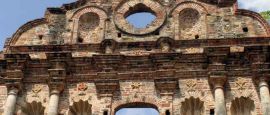Panama History, Language and Culture
History of Panama
Panama’s earliest inhabitants were hunter-gatherers and lived on the land some 10,000 years ago. Apart from the remains of tribal people, archaeologists have discovered some traces of ancient life such as statues, gold ornaments, and some of the earliest ceramics ever found in the Americas.
The Spanish arrived in 1502 and established the original Panama City less than 20 years later. Spain transformed the entire continent, establishing its own colonial society and obliterating the ancient civilisations. Panama City was the starting point of the expedition that ended up conquering the Inca Empire.
After 300 years of colonial rule, the region finally gained independence from Spain in 1821 and formed the state known as Gran Colombia, which included Colombia, Venezuela, Panama and Ecuador. By the end of the century the territory was tearing itself apart and in 1903 Panama broke free from an unhappy union with neighbouring Colombia.
The building of the Panama Canal, which was completed in 1914, was to change everything for Panama. 75,000 labourers of all nationalities flocked to Panama at the prospect of work and building a new life for themselves, bringing in a huge influx of different cultures. The US government bought the rights to the Panama Canal Zone, assuming a huge influence in the running of the country, and the wealth generated by the canal went largely to US interests.
The 20th century was marked by political strife and wrestling matches over rights to the canal. Following his military coup in 1968, General Omar Torrijos Herrera imposed a dictatorship, which continued until his death in 1981. Torrijos was succeeded by his former intelligence chief, Manuel Noriega, who remained in power until 1989, by which time US relations had collapsed and financial assistance cut, in reaction to allegations of election fraud and drug trafficking. When President George Bush sent in a military invasion to wrest power from Noriega, in December 1989, the country was suffering from a crippling lack of funds.
Panama struggled back to economic stability throughout the 1990s, ending positively with the defining moment of its history: the official handing over of the Panama Canal by the US to Panama, successfully concluding a treaty signed in 1977. The completion of a multi-billion dollar Panama Canal expansion project in 2016 more than doubled its operating capacity. Proposed by the then-Panamanian President Martín Torrijos, son of the former dictator, the project was completed a decade later under the current President of Panama, Juan Carlos Varela.
Did you know?
• When General Noriega took refuge in the Vatican Embassy during the US invasion of 1989, they played loud rock music, including Van Halen (Panama) and the Clash (I Fought the Law), to drive him out.
• Panama has 59 of the world’s 356 species of hummingbird, including the smallest bird in the world, the 5-cm bee hummingbird.
• Panama Hats come from Ecuador, not Panama; they got their name in the 19th century because they were first shipped to Panama before being exported around the world.




 You know where
You know where